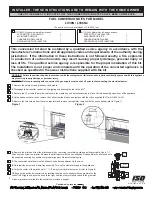
CREOSOTE - ITS FORMATION AND NEED FOR REMOVAL:
When wood is burned slowly, it may produce tar and other organic vapors, which combine with expelled
moisture to form creosote. The creosote vapors condense in the relatively cool chimney of a slow-burning
fire. As a result, creosote residue accumulates on the flue lining. When ignited this creosote makes an
extremely hot fire. The chimney connector and chimney should be inspected bi-weekly during the heating
season to determine if a creosote buildup has occurred. If creosote has accumulated (3mm or more) it
should be removed to reduce the risk of a chimney fire.
MAINTENANCE:
At the end of each heating season clean the chimney and the smoke pipe. If soot has accumulated above
the top baffle bricks, remove, clean, and then replace them. If a secondary air tube is badly corroded,
replace it. Replace worn door gaskets and broken bricks as needed.
FAILURE TO INSPECT AND CLEAN YOUR CHIMNEY SYSTEM REGULARLY CAN RESULT IN A
CHIMNEY FIRE, WHICH COULD DAMAGE THE CHIMNEY OR CAUSE A HOUSE FIRE.
CHIMNEY OR RUN AWAY FIRE:
1. Call local fire department (or dial 911)
2. Close the draft fully
3. Examine the flue pipes, chimney, attic, and roof of the house, to see if any part has become hot
enough to catch fire. If necessary, spray with fire extinguisher or water from the garden hose.
4. Do not operate the stove again until you are certain the chimney and its lining have not been
damaged.
B
uilding
Y
our
F
ire
:
Proper operation of your stove will help to ensure safe, efficient heating. Please take a few moments to
review these simple operating procedures.
IMPORTANT: Please be aware when loading your stove that the air tubes in the rear are lower.
1. Fuel Selection:
This stove is designed to burn natural wood only. Higher efficiencies and lower emissions generally result
when burning air-dried seasoned hardwoods, as compared to softwoods or too green or freshly cut
hardwoods. DO NOT BURN the following: treated wood, coal, garbage, solvents, colored papers or trash.
Burning these may result in the release of toxic fumes and may poison or render the secondary air tubes
ineffective. Burning coal, cardboard or loose paper can produce soot, or large flakes of char or fly ash that
can coat the combustor, causing smoke spillage into the room, and rendering the combustor ineffective.
2. Building/Maintaining a Fire:
a) Open the primary air slide by pulling it all the way to the right.
b) Place a base of crumpled uncolored newspaper in the bottom of the stove. Lay pieces of kindling on
top of the newspaper and light it.
CAUTION: “Never use gasoline, gasoline-type lantern fuel, kerosene, charcoal lighter fluid,
or similar liquids to start or “freshen up” a fire in this heater. Keep all such liquids well
away from heater while it is in use.
c) As the kindling begins to burn, add several larger pieces of wood until the fire is burning well. At this
point, regular size logs may be added.
Operating Instructions
5






































